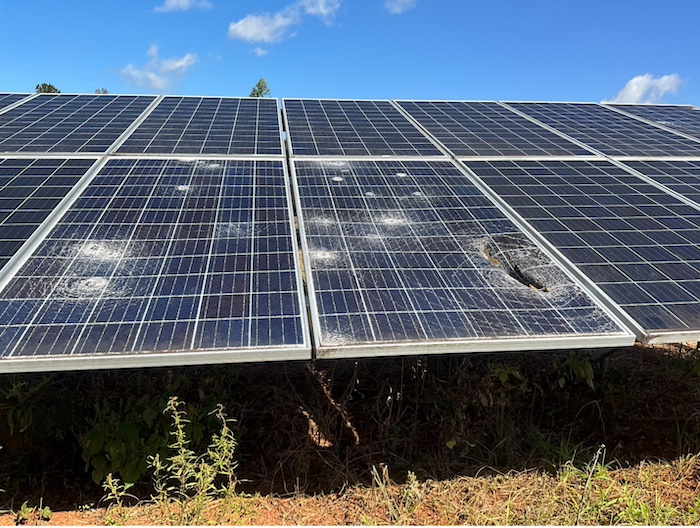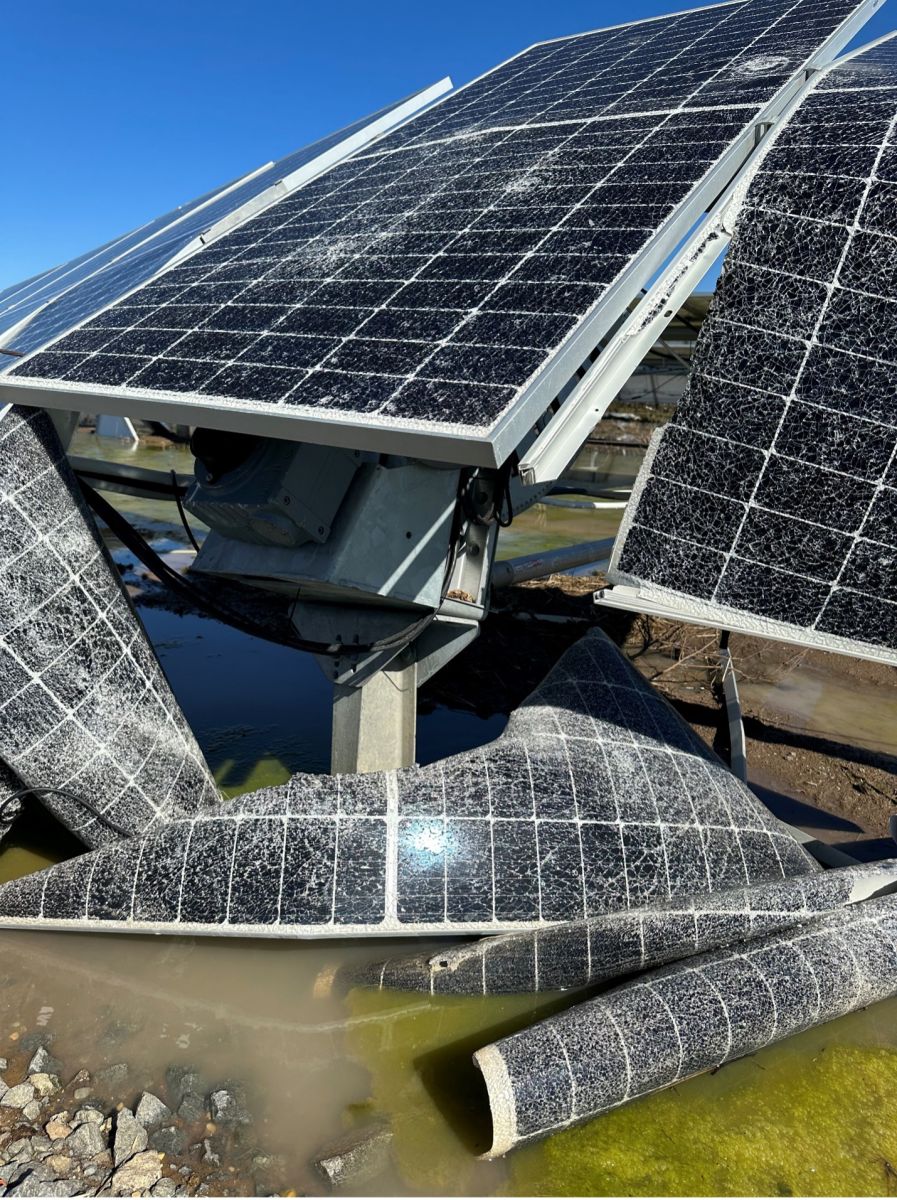After the Storm: A plan to minimize damage and speed solar restoration
2023 set a new record for the number of weather disasters surpassing $1 Billion in damage. Utility-scale solar will face increasing vulnerabilities as the industry grows amid continued catastrophic events. Owners and asset managers can minimize risks from two directions: a strategic plan to prevent losses, and an effective approach to speeding recovery.
Owners and investors are often shocked at the cost of restoring damaged solar plants, including the capital cost of restoration and lost revenue from downtime. Outdated and hard-to-find replacement equipment, racking redesign, and reconfiguration due to evolving changes in form factor and electrical characteristics of PV panels, the degree of experience and/or availability in the workforce, and long lead times — all of these contribute to protracted and costly restoration timelines.
Planning ahead becomes even more critical as insurance companies assess their own exposure in light of weather disasters that lead to skyrocketing premiums and reduced coverage. The result? A greater burden of risk is falling on asset owners.

PV plant after a tornado
Proactive planning – an underutilized tool
Globally, for every $100 spent on weather disaster recovery aid in 2010-2018, as little as $0.47 was allocated to mitigating disaster risk . Switching the focus from after-the-fact rebuilding to proactive prevention can protect against unnecessary lost revenue, potential penalties, and higher insurance costs.
Effective planning requires a framework and stakeholder engagement across all areas of solar, including EPCs, safety, commissioning, and O&M. This framework helps owners and asset managers put site-specific preventative measures in place to recover more quickly and effectively in the case of a catastrophic event. Utilizing this framework for assessing risk and developing mitigation strategies can potentially save months of time and millions of dollars.
Strategic solar framework
A strategic prevention framework follows these basic steps: assess risks, develop a risk management plan, evaluate alternatives, select the best solutions, and implement the plan.
- Assess Risk
An example of risk assessment would be an owner or asset manager who determines that hail is a potential risk in a particular geography. Their planning objective is clear: prevent damage and restore the plant back to operation as quickly and safely as possible after a hail event. The biggest risks from high winds and hail are damaged and broken PV modules, including some on the ground.
- Develop a Risk Management Plan
In this case, a plan needs to cover risks such as employee exposure to energized conductors that may be laying in surface water, sharp edges from broken glass, and sheared metal. These types of risks are not always included in typical safety plans, so be sure to add them. The safety plan should also include a triage plan with a ‘containment strategy’ that temporarily reconfigures the site to isolate damaged sections and allow de-energized sections to be repowered safely.
- Evaluate Alternatives
Key to any recovery plan is a threshold for determining when a PV module is broken and should be replaced. While it seems like a simple evaluation, there are complexities involved; modules may not indicate obvious or damage visible to the naked eye. A preventative framework should include tests to determine and measure module efficacy. Recovery planning must also factor in the availability of replacement panels. Older plants may have obsolete modules that are no longer available in the market, with limited options to match the form factor of the current products. This impacts the design of the tracker system used, along with other potential issues that cause a wide range of challenges and delays during the recovery process.
- Select Solutions
Choosing final strategies entails agreements among stakeholders, evaluation of insurance availability and/or impacts, and performance objectives. A proactive plan can prioritize a Plan A solution, but will also need to have a Plan B and Plan C to be effective in maximizing recovery speed. For example, if a PV module is no longer available, is there another module that will minimize the need to reengineer the existing racking? That module can become part of Plan A, with a second supply of a compatible module selected for Plan B. Plan C accounts for a PV module with a different form factor, leading to a strategy involving the consolidation existing non-damaged modules and the installation of a new modified design based on this new product. With Plan C, all of the other forces that impact a plant can come back to the evaluation table — effects of new dimensions on snow load and wind, overall structural integrity, impact on piles and individual components, electrical characteristics, and so on. Last, the costs of handling, disposing of, and recycling damaged materials need to be evaluated and integrated into risk management decisions. Next in the solution set are personnel strategies. Do employees have sufficient experience to respond to disasters, assess damage, and deploy resources safely? A typical staffing plan should include enough employees with the expertise and/or surge capacity to respond. Do you have trusted third parties vetted and available for rapid response? Even the best laid plans need people to carry them out.
- Implement the Plan
 Before finalizing a plan, it’s a good idea to revisit the original objectives. Have you assessed all the viable options to select the best combination of solutions? Does the plan include a realistic understanding of inventory and replacement? Does it offer a preliminary engineering assessment of the solution’s ability to accommodate a range of replacement parts? Do personnel have the identified capacity and experience to safely and quickly react, deploy, and restore the plant to operation? Once the plan has been thoroughly developed and evaluated, the next step is disseminating it to and obtaining agreement from all stakeholders and employees.
Before finalizing a plan, it’s a good idea to revisit the original objectives. Have you assessed all the viable options to select the best combination of solutions? Does the plan include a realistic understanding of inventory and replacement? Does it offer a preliminary engineering assessment of the solution’s ability to accommodate a range of replacement parts? Do personnel have the identified capacity and experience to safely and quickly react, deploy, and restore the plant to operation? Once the plan has been thoroughly developed and evaluated, the next step is disseminating it to and obtaining agreement from all stakeholders and employees.
This scenario was specific to hail, but the framework applies to any weather event or potential risk. With an agreed-upon plan in place, a site’s personnel would be able to jump into action quickly and safely, minimizing costs, and restoring power with greater speed and efficiency. Once a site is down, scrambling to find parts or additional staff is a recipe for delays, frustrations, and escalating costs.
Assessing all types of risk accurately can seem overwhelming, but the right partner experienced in site recovery can help build out a customized framework and put a preventative plan in place. Even with the number of record-breaking weather events, disasters can be less devastating with proactive planning. The benefits of these plans have a positive ripple effect that extends to owners and asset managers, surrounding communities, and the industry at large.
Ananda Hartzell is VP of Business Development at DEPCOM Power, a Koch Engineered Solutions company. He has over 20 years of experience in the photovoltaic industry in all aspects of engineering, product management, and technical sales. DEPCOM has 2 GW of experience with PV plant restoration, climate-readiness, and PV recovery.
DEPCOM Power | www.depcompower.com
Author: Ananda Hartzell
Volume: 2024 May/June










